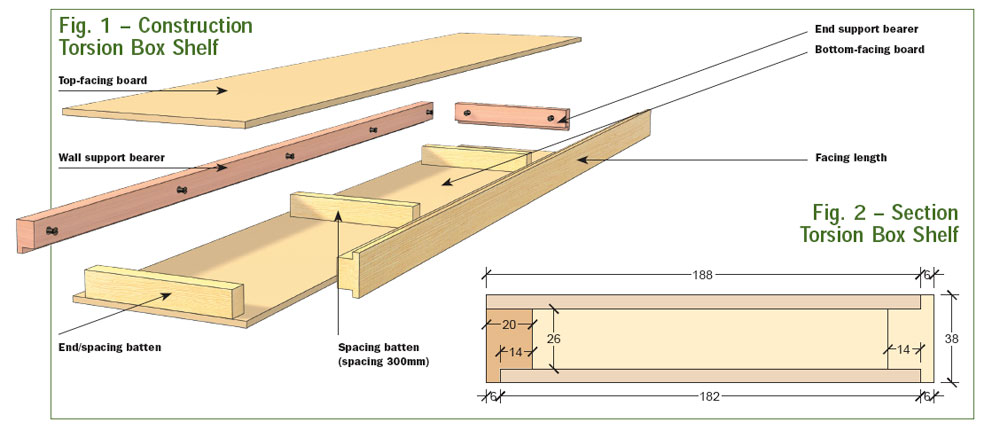Hi,
I was wondering if someone could help me with the following question please;
I have an alcove in my hall and I would like to put in three shelves to hold large hardback books. The alcove depth is 28cm and the width (shelf span) is 76cm. I'm unable to put a rear shelf support at the back of the alcove, so the shelves would only be supported by a timber batten on each side.
Previously, I did a quick, temporary job using 28mm kitchen worktop with some decorative moulding glued to the front edge of the shelves. This has been fine for a number of years, except for the shelves have now bowed and I would like to redo it but using something more substantial. The shelves will be painted so looks isn't a primary concern and I would like to use 18mm MDF as I have plenty of surplus. I've cut the MDF to size and I've glued two pieces face to face, giving me a chunky, and more substantial, 36mm shelf. My initial plan was to support this on either side by sitting the shelves on top of a wooded batten fixed to the sides of the alcove. I'm guessing that a 36mm MDF shelf would be more than man enough for the weight and wouldn't have a problem with bowing over time.
However, I've been thinking that I wouldn't mind having the side supporting battens invisible, thus giving the impression of free-floating shelves. So, I thought why not glue another 18mm piece of MDF onto each shelf, giving me extra thick 54mm shelves. My plan was to then cut a rebate in each side of the shelf, from the back, to stopping just short of the front edge. It would then be a simple matter of just sliding the shelves onto the side-supporting battens, thus, having the battens 'hidden' in the shelf, as opposed to just having the shelves sitting on top of the battens.
And now for my query. If I was to make the rebate in the side of the shelves 18mm wide and I had it positioned in the middle of the shelf's 54mm thickness, that would give me 18mm of shelf thickness above the side support and 18mm below it.
So, what strength would that shelf have?
Would it be the same as a single piece of 18 MDF, as that's all that's sitting above the batten? Or, would it be 54mm's worth of strength, as that's the total shelf's thickness?
I'm not the best at explaining things, so I hope my question makes sense.
Any help would be much appreciated, thank you
I was wondering if someone could help me with the following question please;
I have an alcove in my hall and I would like to put in three shelves to hold large hardback books. The alcove depth is 28cm and the width (shelf span) is 76cm. I'm unable to put a rear shelf support at the back of the alcove, so the shelves would only be supported by a timber batten on each side.
Previously, I did a quick, temporary job using 28mm kitchen worktop with some decorative moulding glued to the front edge of the shelves. This has been fine for a number of years, except for the shelves have now bowed and I would like to redo it but using something more substantial. The shelves will be painted so looks isn't a primary concern and I would like to use 18mm MDF as I have plenty of surplus. I've cut the MDF to size and I've glued two pieces face to face, giving me a chunky, and more substantial, 36mm shelf. My initial plan was to support this on either side by sitting the shelves on top of a wooded batten fixed to the sides of the alcove. I'm guessing that a 36mm MDF shelf would be more than man enough for the weight and wouldn't have a problem with bowing over time.
However, I've been thinking that I wouldn't mind having the side supporting battens invisible, thus giving the impression of free-floating shelves. So, I thought why not glue another 18mm piece of MDF onto each shelf, giving me extra thick 54mm shelves. My plan was to then cut a rebate in each side of the shelf, from the back, to stopping just short of the front edge. It would then be a simple matter of just sliding the shelves onto the side-supporting battens, thus, having the battens 'hidden' in the shelf, as opposed to just having the shelves sitting on top of the battens.
And now for my query. If I was to make the rebate in the side of the shelves 18mm wide and I had it positioned in the middle of the shelf's 54mm thickness, that would give me 18mm of shelf thickness above the side support and 18mm below it.
So, what strength would that shelf have?
Would it be the same as a single piece of 18 MDF, as that's all that's sitting above the batten? Or, would it be 54mm's worth of strength, as that's the total shelf's thickness?
I'm not the best at explaining things, so I hope my question makes sense.
Any help would be much appreciated, thank you




































